[What Data Says] What Is the Best Facebook Video Length?
Want to know how long a video can be on Facebook to get the best engagement? Discover here the best video lengths for different objectives.
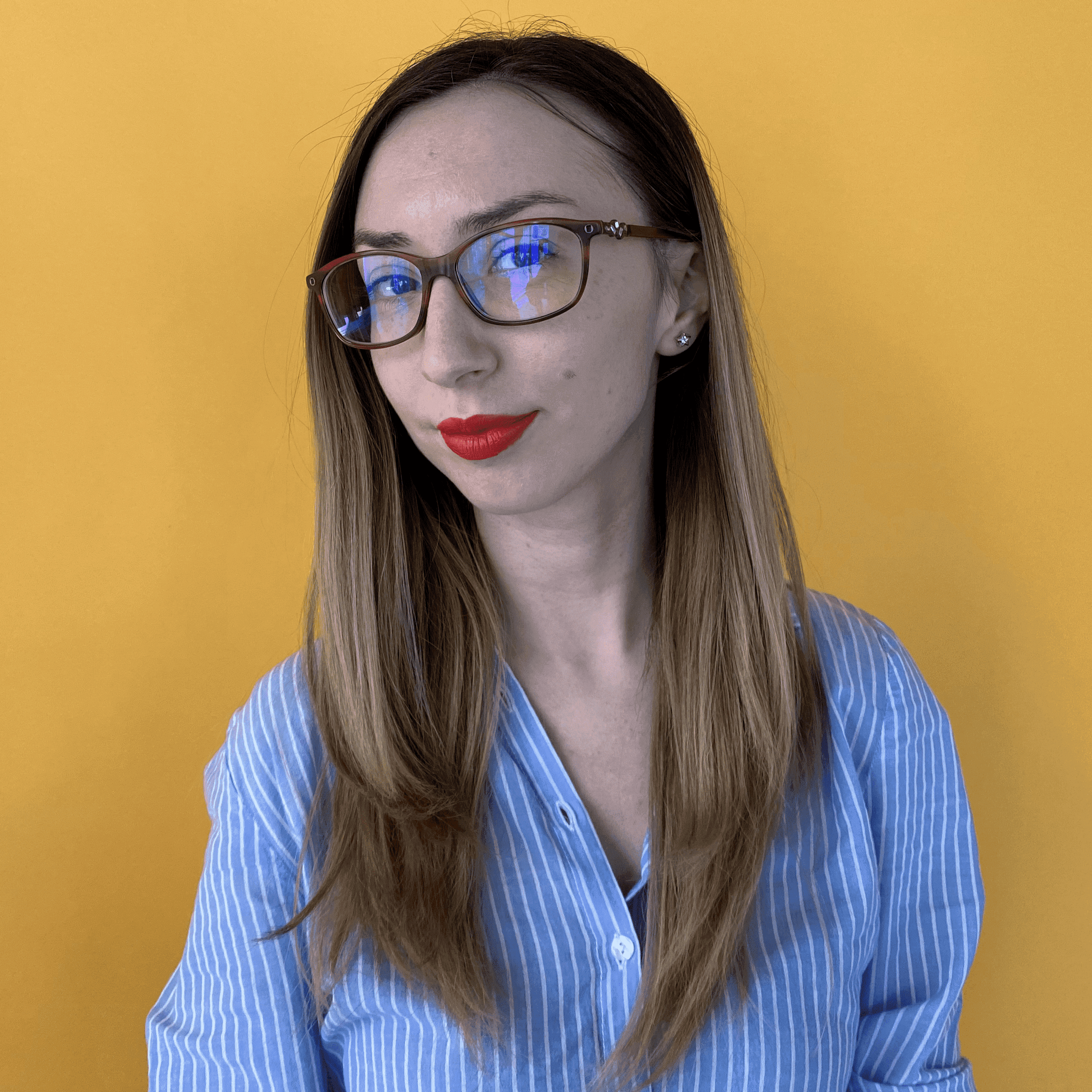
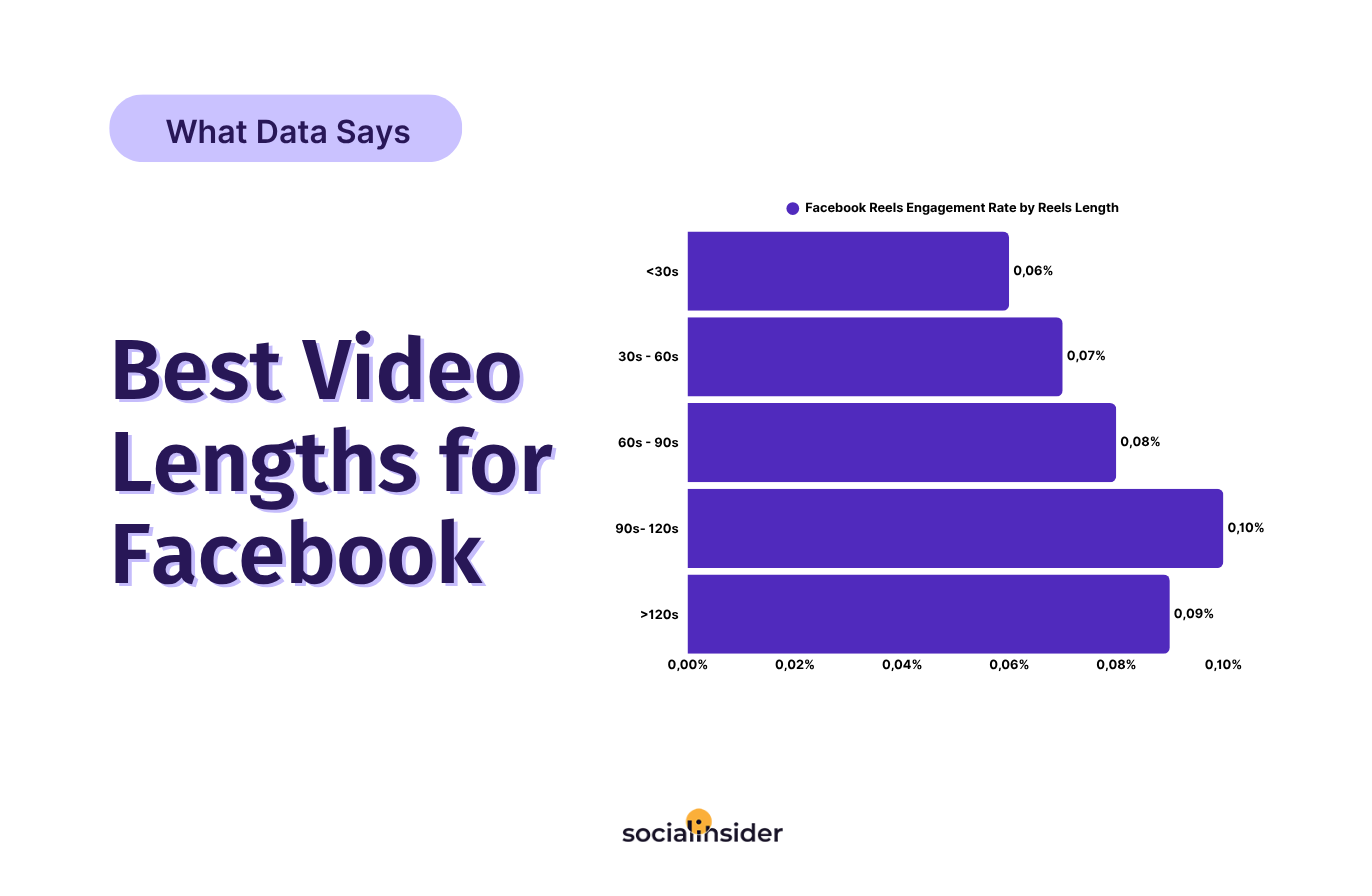
While Facebook may not be known first and foremost as a video platform, video still plays a key role in driving engagement, reach, and audience connection, especially when it’s done right. But the question remains: how long should your Facebook videos actually be?
This study dives into performance data from regular videos, Reels, and Live broadcasts to uncover what lengths work best across different content objectives and types. Whether you’re educating, entertaining, or promoting, you’ll find clear, data-backed answers to help you make smarter video decisions on Facebook.
Executive summary
- Longer Reels also perform better, the best time length being between 60-90 seconds for engagement, comments, share and views.
- While 40 minutes Facebook live videos usually score the highest engagement rate, 50 minutes live session perform better from a comments, share and views perspective.
What is the ideal Facebook video length?
It all comes down to context. The ideal length isn’t just about format — Reels, regular videos, or Lives — it’s also about what you're trying to say.
Educational content usually needs more time to deliver value, while entertainment or promotional content often performs better when it's shorter.
The sections below break it all down, format by format, backed by data that shows what actually works.
Ideal length for Facebook videos
In the world of social media marketing, things move fast - like blinking and it's gone fast. Recently, Facebook has announced a major change, with all its videos now being treated as Reels.
Which means that Facebook Reels are no longer limited to the 90-second frame.
So, how does this impact your strategy?
I'm here to show you how to navigate this change and optimize your Facebook Reels length for a better performance.
Ideal video length for Facebook Reels
With Reels, you’ve got seconds to make it count — but shorter isn’t always smarter. The trick is knowing when to cut and when to stretch.
Here's where length starts to matter, and how the numbers shift as you push past different time marks.
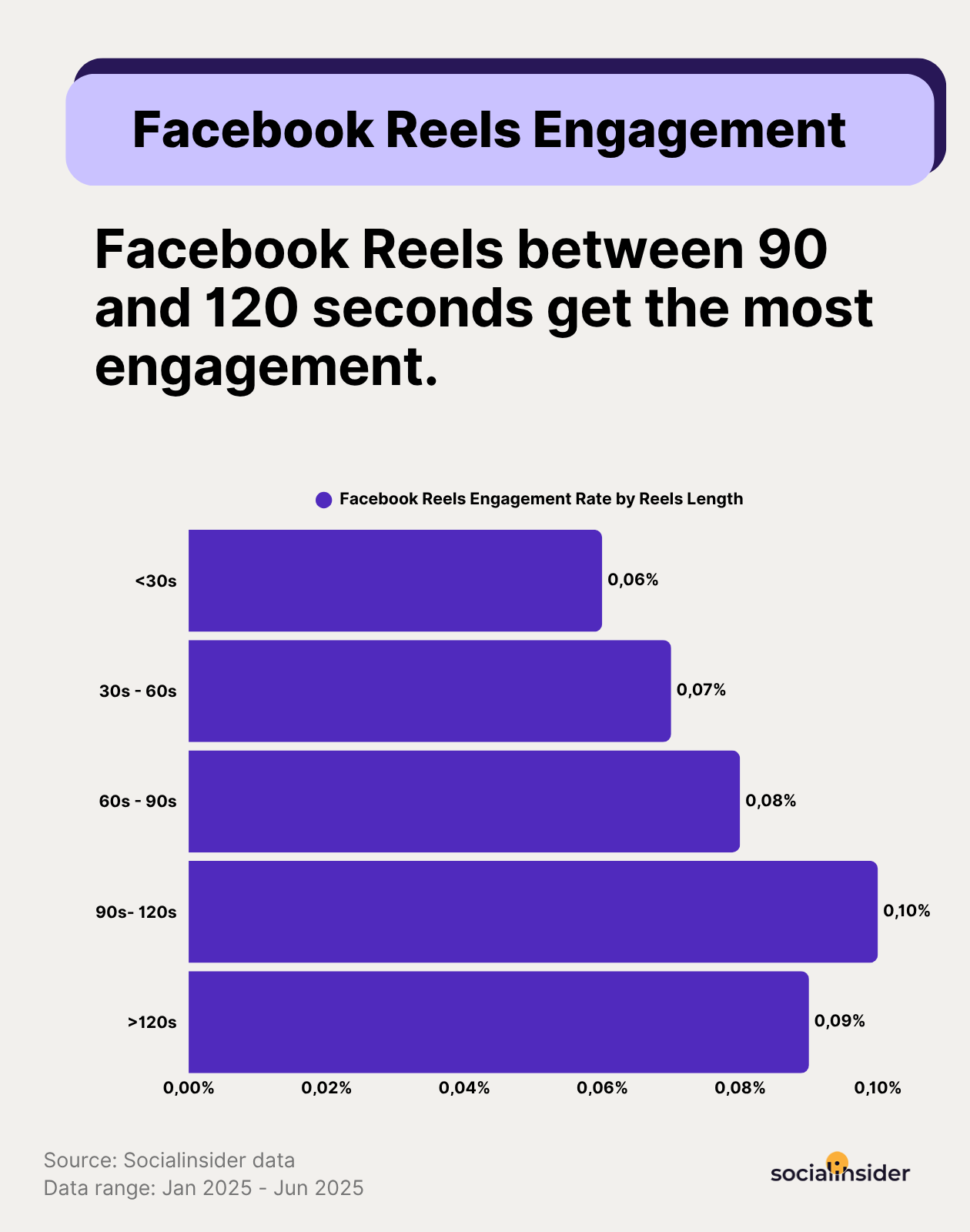
- below 30 seconds - 0.06% engagement rate
Super short clips are quick to produce, but struggle to grab real attention. Great for scroll-stopping, weak for interaction.
- 30-60 seconds - 0.07% engagement rate
A noticeable bump. Enough time to deliver a punchy message, but still limited depth.
- 60-90 seconds - 0.08% engagement rate
Crossing the 60-second line starts to pay off. Viewers begin to stick around.
- 90-120 seconds - 0.10% engagement rate
The peak. Engagement is highest when you reach the 2-minute mark.
- above 120 seconds: 0.09% engagement rate
Slight dip, but still outperforming shorter formats. Longer videos can work — if they stay tight and relevant.
For views
Here’s what this data shouts loud and clear: Reels between 60 and 90 seconds get watched more.
Here’s how average Facebook Reels views break down by video length:
- Under 30 seconds: 4,600 views
Short, fast, and still solid — these are easy to consume but might not offer enough depth to drive repeat views.
- 30s–60s: 4,400 views
Slight dip here. Could signal that this range is too long for quick hits, but too short to deliver full value.
- 60s–90s: 5,000 views
Top performer. Reels in this range offer just enough time to tell a story, deliver a punchline, or showcase a transformation — all without dragging.
- 90s–120s: 4,100 views
A clear drop-off. Once you cross 90 seconds, viewership starts to taper. Could be due to retention issues or limited discoverability in the feed.
- Over 120s: 3,600 views
Lowest performance. Attention fades fast once Reels stretch beyond their expected range.
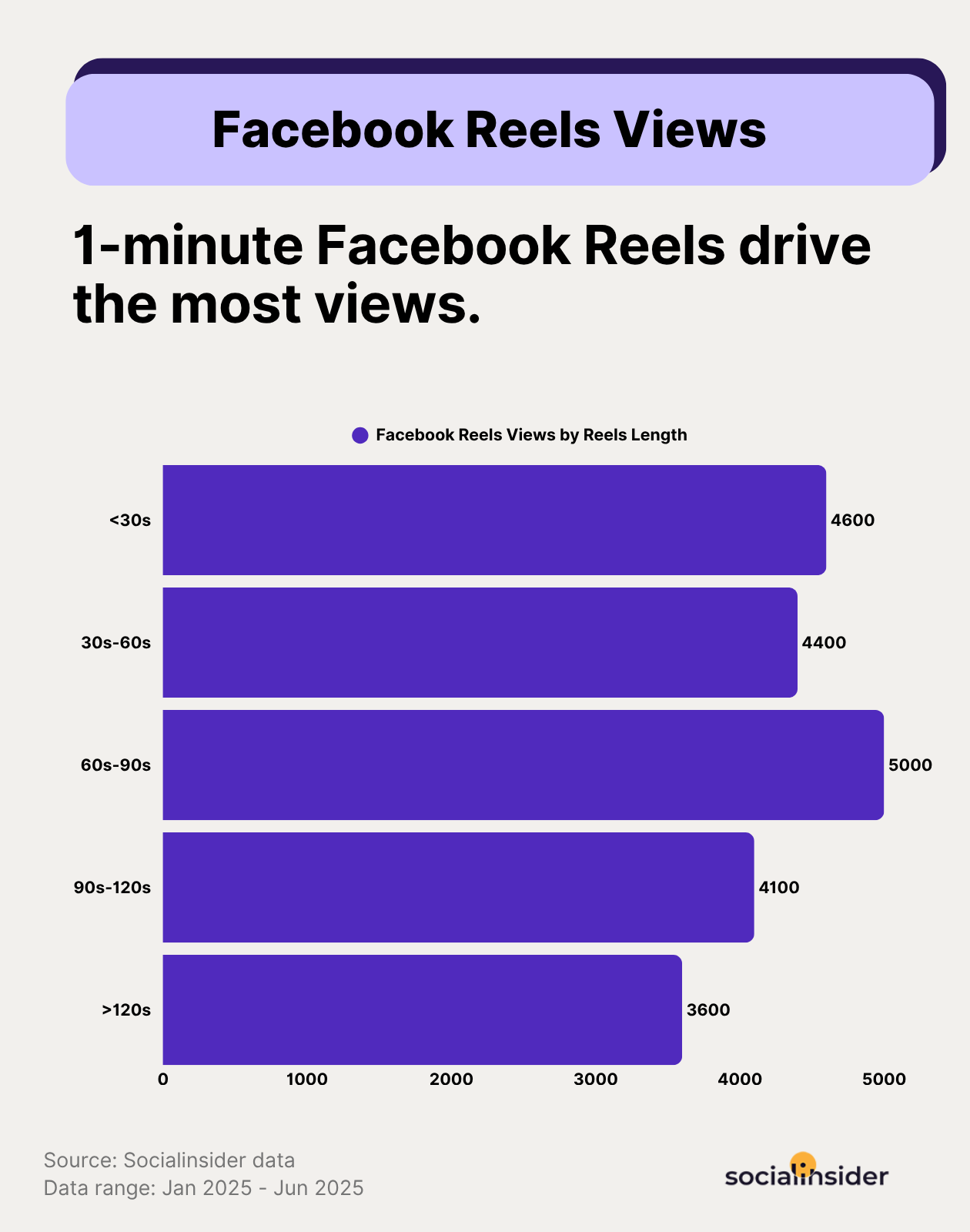
Even if Facebook allows longer Reels in some cases, 60–90 seconds is still the sweet spot for driving views. It's long enough to deliver impact but short enough to hold attention. Going beyond 90 seconds leads to a noticeable drop — so unless the content demands more time, it’s better to keep it tight.
Our verdict: how long can a Facebook Reel be?
The data shows Reels that land in the 60–90 second range consistently outperform shorter clips in both terms of engagement and views. And that's because longer Reels give you room to tell a story, land a message.
Still, don’t stretch just to fill time. If the idea hits in 30 seconds, post it. But if you’ve got something strong, don’t cut it short — let the full 90 seconds work for you.
Ideal length for Facebook live videos
Live videos play by different rules. You’re not just posting — you’re performing. And how long you stay live can make or break the outcome. Cut it short, and you miss your moment. Drag it out, and you risk losing the room.
The data ahead shows when to go long, when to wrap it up, and how to keep the energy high from start to finish.
For engagement
Engagement is the heartbeat of any Facebook Live. Unlike pre-recorded content, Live videos depend on real-time reactions — comments, likes, emoji bursts — to keep momentum going.
And more importantly? Facebook’s algorithm loves Live videos with strong engagement, rewarding them with longer visibility and broader reach while you’re still live.
But engagement isn’t flat — it rises and falls depending on how long you stay live.
Here’s how the numbers stack up:
- Under 20 minutes → 0.03% engagement
Not enough time to build traction. Most viewers haven’t even joined before you’re done. - 20–30 minutes → 0.05% engagement
A solid lift. You’ve got enough runway here to welcome viewers, set context, and start driving reactions. - 30–40 minutes → 0.07% engagement
Highest engagement rate. This is your golden zone — long enough to go deep, short enough to hold attention. - Over 40 minutes → 0.03% engagement
Engagement drops hard. Likely due to fatigue or diminishing returns unless the content is truly compelling.
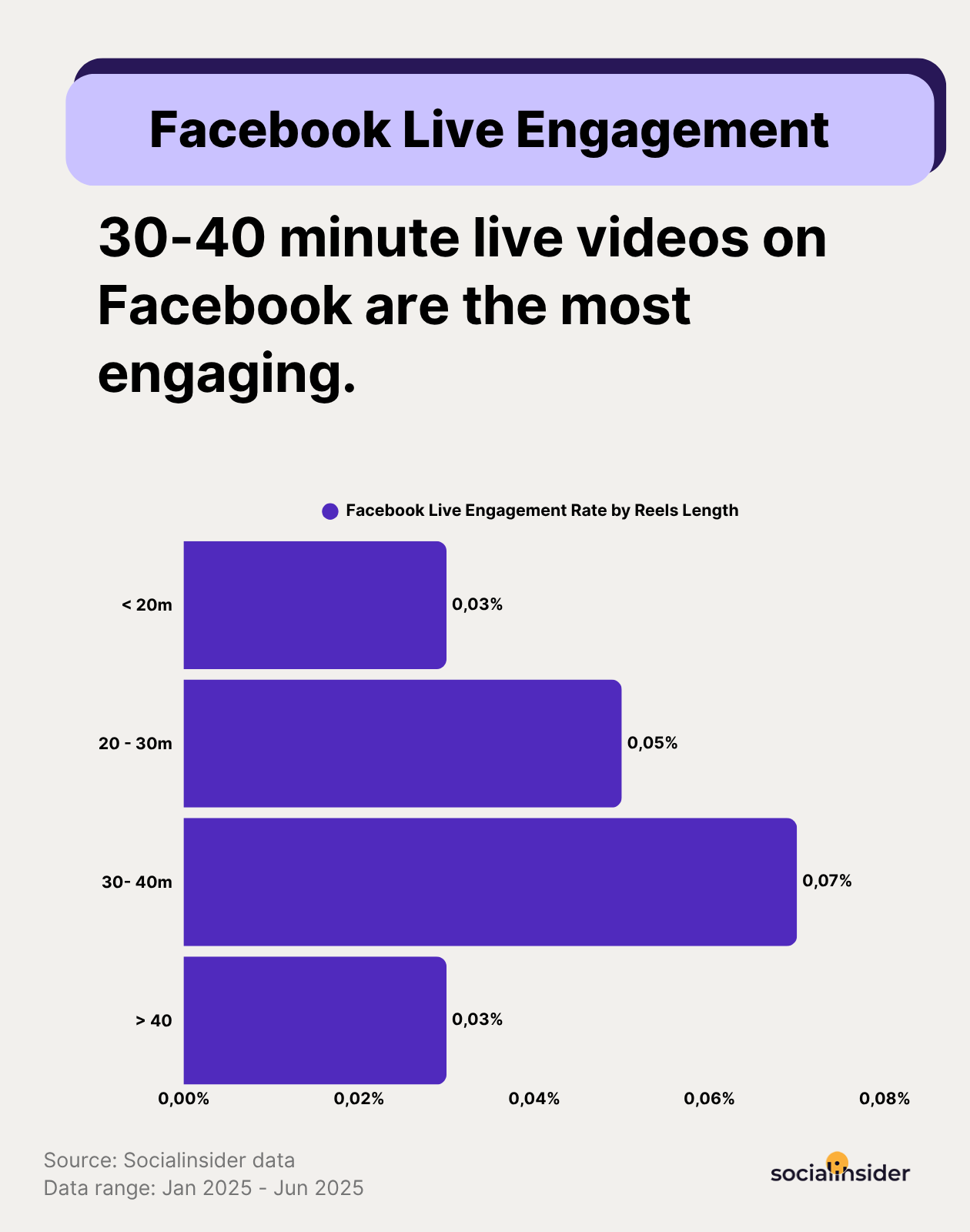
For comments
If you want conversation, Live is where it happens — but timing is everything.
Why do comments matter so much for Facebook Lives? Because they’re more than feedback — they’re fuel. Every comment tells the algorithm your video is active, relevant, and worth keeping in the feed. It also creates a loop: the more comments you get, the more your live gets shown, and the more people jump in to comment.
Here’s how the comment volume builds over time:
- 10–20 minutes → 18 comments
A slow start. You’re likely talking to early viewers, maybe answering a few questions. - 20–30 minutes → 19 comments
Slight uptick. You’re building momentum, but the real action hasn’t started yet. - 30–40 minutes → 29 comments
Big jump. More people are in the room, chat is flowing, and your content is connecting. - 40–50 minutes → 28 comments
Still high. You’re deep in conversation territory, handling live feedback and real-time reactions. - Over 50 minutes → 46 comments
Huge leap. If you’ve kept your audience this long, they’re talking — a lot.
So what’s the takeaway here?
While engagement rates peak earlier, comments just keep climbing. That means if your content has depth — a live Q&A, a launch, an in-depth walkthrough — going beyond 50 minutes can actually pay off. People start interacting more as they get invested.
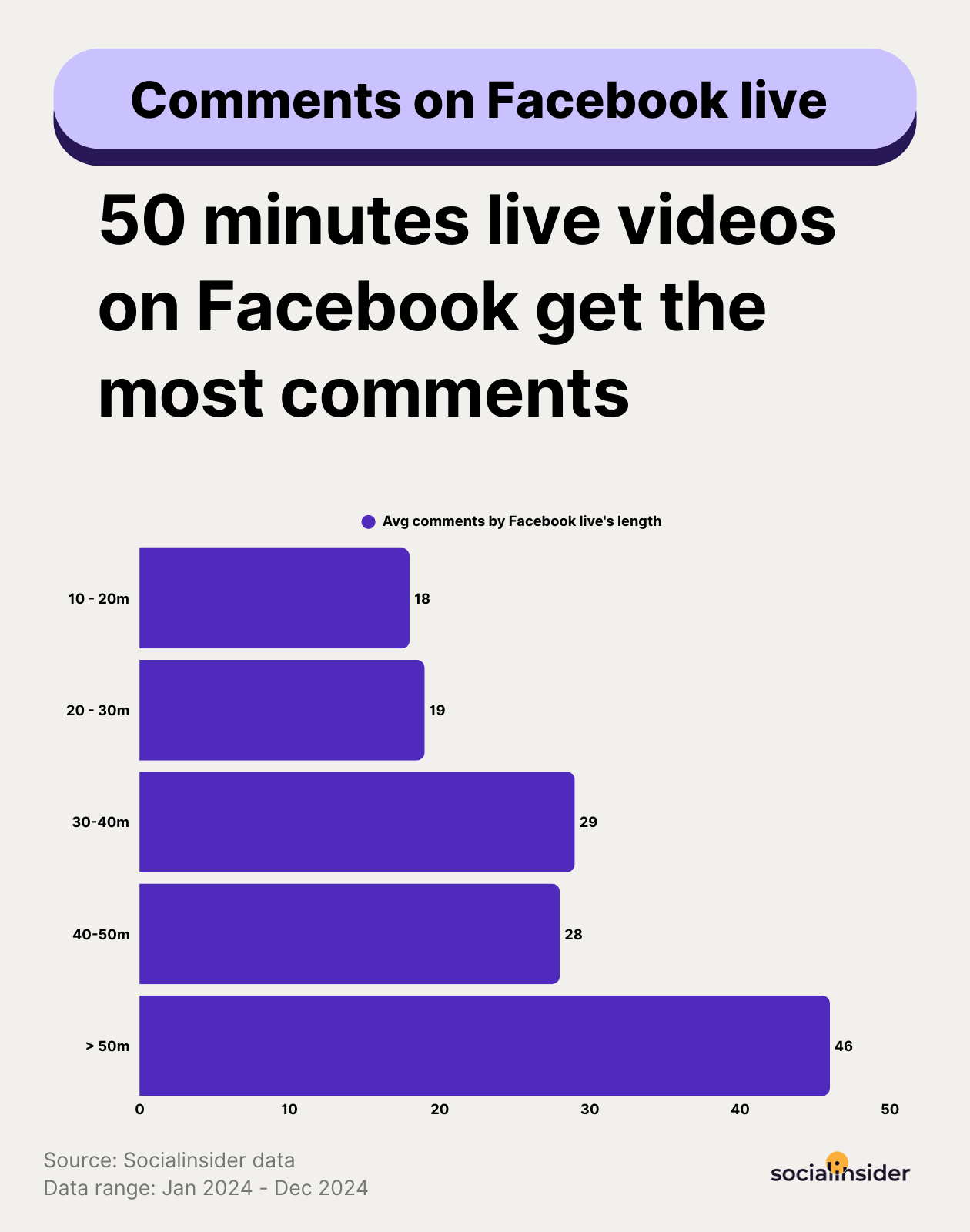
For shares
Shares are the holy grail of Live content — but they’re not easy to earn. Unlike quick reactions or passive comments, a share means someone found real value in what you’re doing — enough to tell others, “Hey, you need to see this.”
With Lives, shares build slower than other engagement signals. But when they show up, they show up big.
Here’s the breakdown:
- 10–20 minutes → 8 shares
Early viewers are watching, not sharing. You haven’t built enough context or momentum yet. - 20–30 minutes → 8 shares
Still flat. There’s interest, but not quite enough impact for people to spread the word. - 30–40 minutes → 7 shares
Slight dip — often a transitional zone. If your content feels like it’s dragging, shares drop off. - 40–50 minutes → 10 shares
Engagement picks up again. If the conversation’s flowing and you’re delivering insights, people start passing it along. - Over 50 minutes → 23 shares
Massive jump. Once you pass the 50-minute mark, shares more than double. That’s where deep value kicks in.
So what’s really happening here?
Short Lives might spark interest, but they rarely create share-worthy moments. It’s the long, meaty, content-rich sessions that viewers feel compelled to share, especially if there’s exclusive info, powerful storytelling, or a clear call to action.
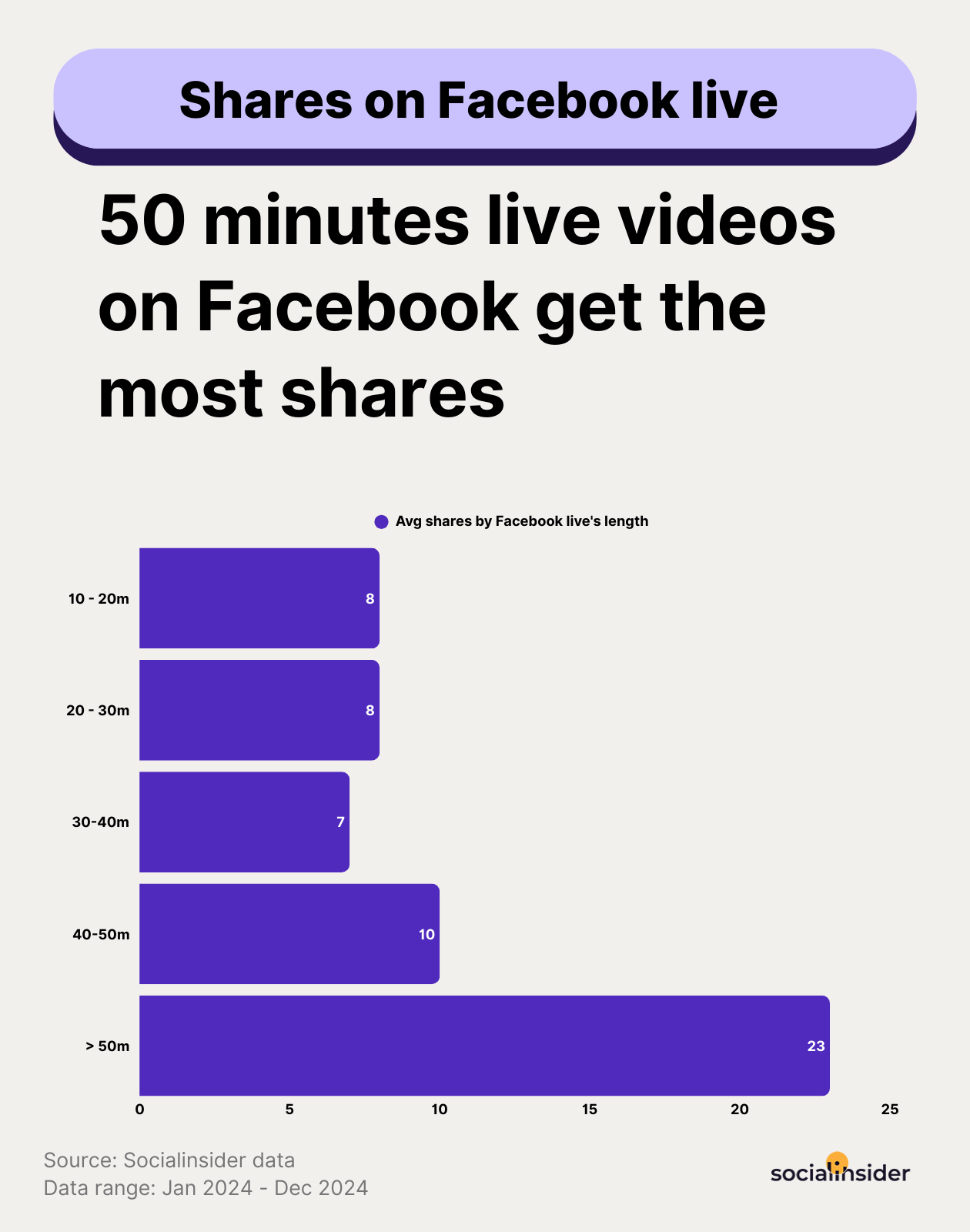
Our verdict: how long can Facebook live videos be?
Facebook Live videos can run up to 8 hours — but unless you're livestreaming a conference or a concert, that’s overkill.
What actually works? 30–40 minutes is the high-performance zone for engagement and shares. That’s when people are active, chatting, and spreading the content.
Go over 50 minutes, and comments start climbing — but only if the content holds up. If you're bringing real value — think launches, Q&As, deep dives — then pushing past 50 minutes can seriously pay off.
The key? Don’t just go long. Go long with purpose.
Content type and its impact on ideal video length
The truth is, there’s no one-size-fits-all rule for video length on Facebook — because not all content is created with the same purpose. What works for entertainment won't land the same way for education, and a quick-hit promo shouldn’t try to mimic a 50-minute livestream.
But thanks to the data, we now know how video length performs when it’s matched to the right kind of content. Here’s how to make that pairing work.
Educational content: when longer videos perform better
Educational videos thrive on clarity, not speed. If you’re teaching, explaining, or demonstrating something, you need time — and your audience is willing to give it.
Across all formats, the longer the educational content, the better it performed:
- Regular videos hit peak engagement and views in the 2–4 minute range
- Facebook Lives with an educational hook (think tutorials, webinars, or Q&As) saw massive comment volume and shareability once they passed 50 minutes
- Even Reels, when stretched to 60–90 seconds, performed better when used for tips, summaries, or quick explainers
Entertainment: optimal engagement lengths
When you're entertaining, you're competing with a scroll — and the scroll is ruthless.
But here’s the twist: our data showed that longer entertainment works… when it stays entertaining.
- Reels between 60–90 seconds pulled the most views and shares — enough time to build up a punchline or deliver a mini story
- Regular videos around 3 minutes drove top engagement, suggesting that audiences are totally fine with sticking around if it keeps them interested
- Lives were only effective for entertainment when they crossed the 40-minute mark and stayed interactive or surprising.
Promotional content: finding the balance between information and brevity
Promotional content lives or dies by how fast it can connect with value. You're not just selling — you're convincing someone to care, fast.
Based on the data:
- Regular videos between 30s and 2 minutes strike the best balance — just enough time to introduce a problem, show the product, and land a call-to-action
- Reels around 45–60 seconds are optimal for quick product highlights, launches, or testimonial snippets
- Lives work here only if you’re doing something special — a product drop, an event, or something your audience is actively waiting for. In that case, 40–50 minutes gets the most interaction.
However, you don’t have to stick to these time intervals no matter what. The secret is to take these tips as a starting point and then check your own data to find that sweet spot for your audience. Because the truth is that different audiences want different things.
You can easily gain insights that will help you optimize your Facebook video marketing strategy with a social media analytics tool, such as Socialinsider, that allows you to track advanced video performance metrics, such as engagement by video length, or video posts engagement distribution, as you can see in the image below.

To get this data, you have to:
- Go to the Home section and click on the connect social accounts.
- Select the Facebook page you want to connect
- Then head over to the Video section, where you’ll see plenty of data.
Additionally, by tracking your videos’ engagement evolution, you can identify potential spikes or drops and easily pinpoint the videos that generated them. This will further help you optimize your strategy, by identifying how effective videos look like and what types it’s best to avoid.
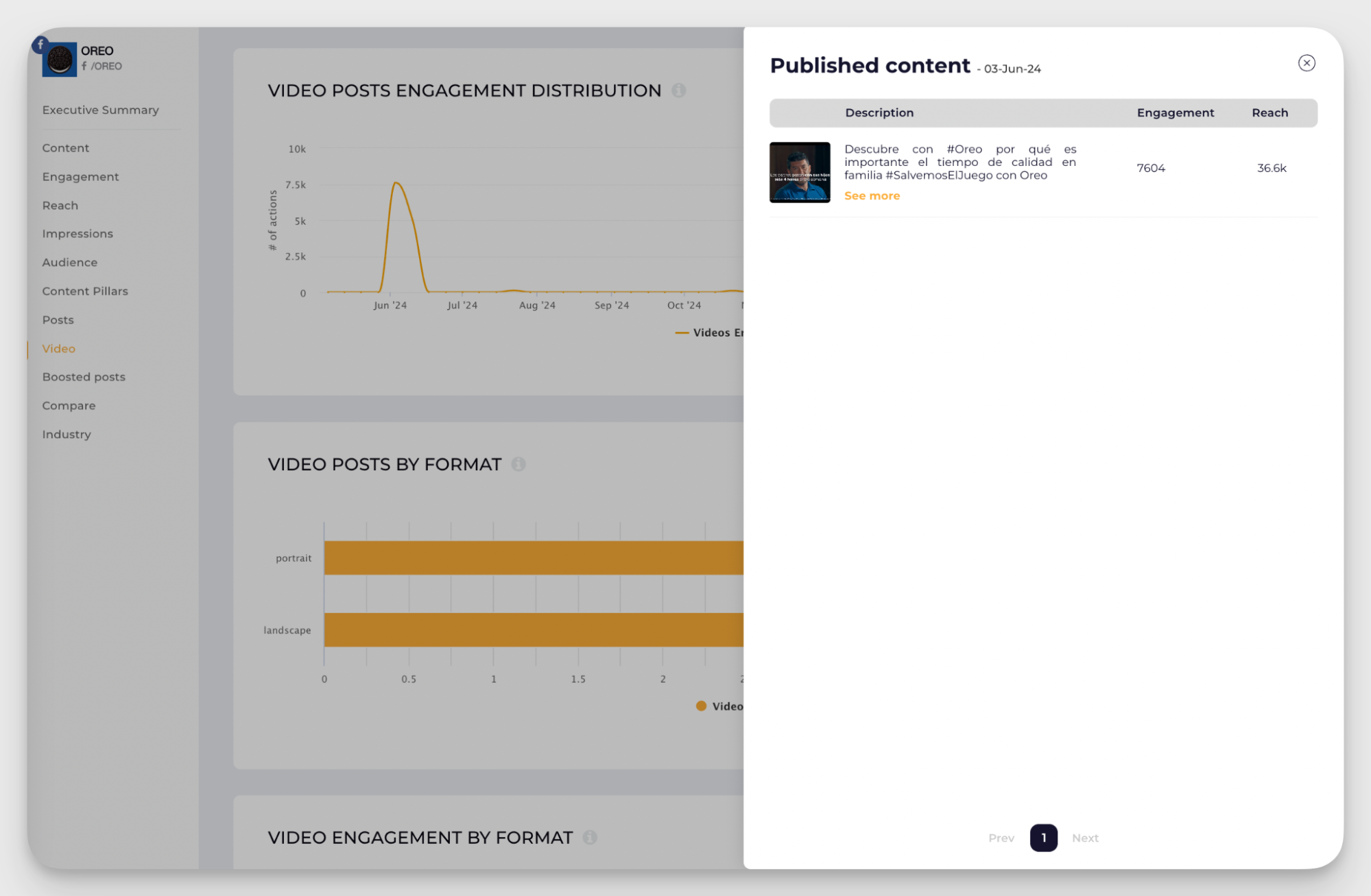
User-generated content: length considerations
UGC is powerful because it feels real. But real doesn’t mean random — length still matters.
What we saw:
- Short Reels (30–60 seconds) work best for raw reactions, testimonials, or behind-the-scenes content
- Longer UGC in regular videos — 90–120 seconds — performed better when there was a narrative: before/after stories, problem/solution moments, or mini case studies
- Lives are generally not UGC-friendly unless they’re co-hosted or spotlighting a community member. Even then, keep it under 50 minutes unless it’s event-style content
Advanced video strategy - beyond just length
Length gets you in the game. But what keeps people watching, clicking, and sharing? These advanced tactics will make every second of your video count.
Retention techniques for longer videos
- Break up your pacing with pattern interrupts — quick cuts, music shifts, or surprise visuals — especially around the 30s, 60s, and 90s marks.
- Tease value early, then deliver in chunks. Say “Later in this video, I’ll show you…” and give people a reason to stick.
- In longer Lives or videos over 3 mins, use on-screen text or voice reminders to keep viewers engaged: “Still with me? Here’s the good part.”
Hook strategies for the crucial first 3 seconds
- Start with movement or emotion — big gestures, bold statements, or facial expressions that break the scroll.
- Use text overlays to pose a question or make a promise: “What happens if you stop posting for 7 days?”
Using chapters and segments to increase watch time
- For videos over 2 mins, structure like a story: intro → setup → payoff → takeaway. That natural progression keeps viewers invested.
- Add timestamps or visual markers in Lives or long-form to let people jump or re-engage later.
- Repeat key themes every 30–60 seconds to keep late joiners or rewatchers grounded.
Thumbnail optimization for higher click-through rates
- Close-up faces, clear emotion, and high contrast colors grab attention fast.
- Use short, punchy text to tease content: “You Won’t Believe This…” or “The One Strategy I’d Never Skip.”
To quickly identify what your top videos were over a certain time, you can easily head over to Socialinsider, go to the Posts section, and filter performance by content type through the right-sided menu.
With this approach, you can spot the best-performing content formats in seconds.
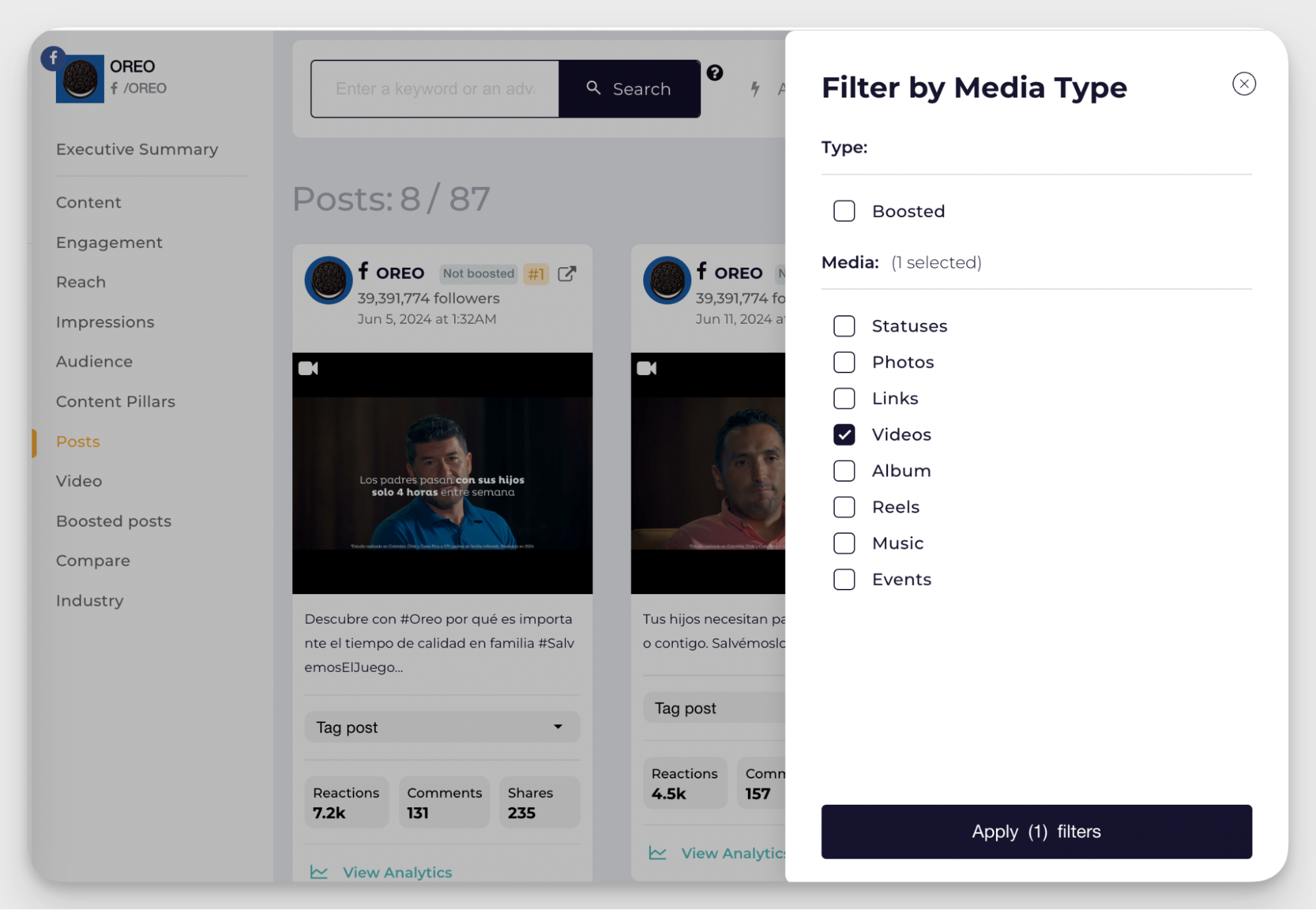
Final thoughts
The findings of the study were based on the analysis of 3M regular Facebook videos, 1M Facebook Reels, and 705K live sessions, published between January 2024 and December 2024.
Please remember that, depending on your industry and audience size, your video analytics may indicate different best practices. These benchmarks offer some light into how different types of videos perform, based on various lengths, but it's always best to optimize your strategy based on your own performance insights.
Quickly get access to in-depth analytics data for your page by starting a 14-day free Socialiniser trial!
Analyze your competitors in seconds
Track & analyze your competitors and get top social media metrics and more!
You might also like
Improve your social media strategy with Socialinsider!
Use in-depth data to measure your social accounts’ performance, analyze competitors, and gain insights to improve your strategy.


![[What Data Says] Zero-Click Content for Social Media](https://blog-cms.socialinsider.io/content/images/2025/10/zero-click-content-cover.png)

